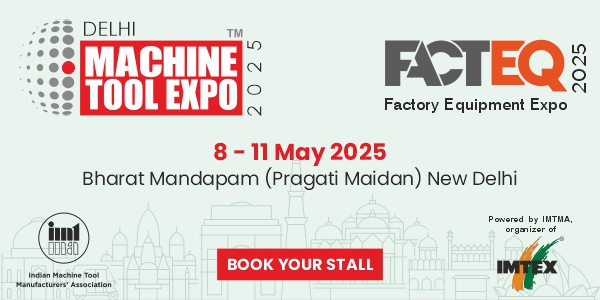The manufacturing sector in India is undergoing a transformative shift with the rapid adoption of automation and robotics. As the country strives to become a global manufacturing hub under the ‘Make in India’ initiative, industries are increasingly integrating smart technologies to enhance productivity, efficiency, and competitiveness. The rise of Industry 4.0, coupled with advancements in artificial intelligence (AI), machine learning (ML), and the Internet of Things (IoT), has further accelerated the adoption of automation and robotics in manufacturing processes.
The Evolution of Automation in Indian Manufacturing
India’s journey toward automation began with mechanization and computer numerical control (CNC) machines, gradually moving towards programmable logic controllers (PLCs) and robotics.
Initially, automation was restricted to large multinational corporations with deep pockets, but today, even small and medium enterprises (SMEs) are exploring automation solutions to remain
competitive.
The integration of robotics started gaining traction in the automotive sector, where precision and consistency are paramount. Leading automobile manufacturers have deployed robotic arms for welding, painting, and assembly operations, ensuring uniform quality and reducing dependency on manual labor. Over time, sectors such as electronics, pharmaceuticals, and consumer goods
have also embraced robotics to optimize production.
Types of Automation & Robotics in Indian Manufacturing
Industrial Robotics
Industrial robots, including articulated robots, SCARA robots, delta robots, and collaborative robots (cobots), have become essential in modern manufacturing setups. These robots handle material handling, assembly, welding, and packaging operations, significantly reducing cycle times and improving consistency.
Collaborative Robots (Cobots)
Cobots are gaining popularity in Indian industries due to their ability to work alongside humans without extensive safety enclosures. SMEs, in particular, benefit from cobots, as they are costeffective and easy to integrate into existing production lines.
Automated Guided Vehicles (AGVs) & Autonomous Mobile Robots (AMRs)
AGVs and AMRs are transforming intralogistics within manufacturing plants. These self-navigating robots transport raw materials and finished goods across the factory floor, minimizing human
intervention and improving efficiency.
Additive Manufacturing & 3D Printing
Automation in the form of additive manufacturing, commonly known as 3D printing, is revolutionizing prototyping and low-volume production. The automotive, aerospace, and healthcare industries are leveraging 3D printing to create intricate components with reduced material wastage.
Artificial Intelligence & Machine Learning in Automation
AI-powered automation systems analyze vast amounts of data to optimize manufacturing operations. Predictive maintenance, anomaly detection, and process optimization are some areas
where AI-driven automation is making a significant impact.
Smart Manufacturing & IoT Integration
The integration of IoT devices in manufacturing enables real-time monitoring of equipment, predictive analytics, and remote troubleshooting. Smart factories leverage IoT sensors
to enhance operational efficiency and minimize downtime.
Innovations in Factory Automation
Factory automation is witnessing groundbreaking innovations that are redefining production efficiency. Advanced robotics powered by AI and ML are enabling adaptive learning,
where machines improve performance over time. Digital twins, virtual replicas of physical assets, are being used to simulate production scenarios and optimize workflows before actual
implementation. Edge computing is reducing data latency, allowing real-time decisionmaking on the shop floor. Additionally, the integration of blockchain technology in manufacturing is
enhancing supply chain transparency and traceability. With these innovations, Indian factories are becoming smarter, more agile, and capable of meeting evolving market demands.
Key Drivers of Automation in Indian Manufacturing
- Labor Shortages & Rising Costs – With increasing labor costs and skill shortages, automation is becoming a viable alternative to maintain production efficiency.
- Quality & Precision – Robotics and automation ensure uniform product quality, reducing rework and defects.
- Government Initiatives – Programs like ‘Make in India’ and ‘Atmanirbhar Bharat’ encourage technological advancements in manufacturing.
- Foreign Direct Investment (FDI) – Increased FDI in sectors like electronics and automotive has driven the demand for advanced manufacturing technologies.
- Technological Advancements – The rapid progress in AI, ML, and IoT is making automation more accessible and affordable for Indian manufacturers.
Challenges in Implementing Automation & Robotics
Despite the evident benefits, several challenges hinder the widespread adoption of automation in India’s manufacturing sector:
1. High Initial Investment The cost of deploying automation systems is substantial, making it a hurdle for SMEs.
2. Workforce Resistance & Skill Gap The fear of job displacement and lack of technical expertise slow down automation adoption.
3. Infrastructure Constraints Inconsistent power supply, lack of skilled personnel, and inadequate digital infrastructure pose challenges.
4. Customization Requirements Indian manufacturers often deal with small-batch, high-mix production, which requires flexible automation solutions.
5. Cybersecurity Risks Increased connectivity through IoT raises concerns about data security and potential cyber threats.
Future Trends & the Road Ahead
The future of automation and robotics in Indian manufacturing looks promising, with several trends shaping the industry:
Increased Adoption of AI & Big Data Analytics – AI-driven decision-making will enhance operational efficiency and predictive maintenance.
Expansion of Cobots in SMEs – The affordability and flexibility of cobots will encourage widespread adoption in small manufacturing units.
5G-Enabled Smart Manufacturing – The rollout of 5G will improve connectivity and real-time data exchange, further boosting automation applications.
Sustainable & Green Automation– Energy-efficient robotics and eco-friendly manufacturing processes will gain traction.
Reshoring & Localized Manufacturing – With global supply chain disruptions, India is focusing on self-reliance, increasing demand for automation to meet domestic needs.
Conclusion
Automation and robotics are revolutionizing the Indian manufacturing sector, driving efficiency, quality, and global competitiveness. While challenges persist, the benefits far outweigh the hurdles, making it imperative for businesses to embrace these technologies. As India continues its journey towards becoming a global manufacturing powerhouse, the integration of automation and robotics will play a pivotal role in shaping the future of the industry.





